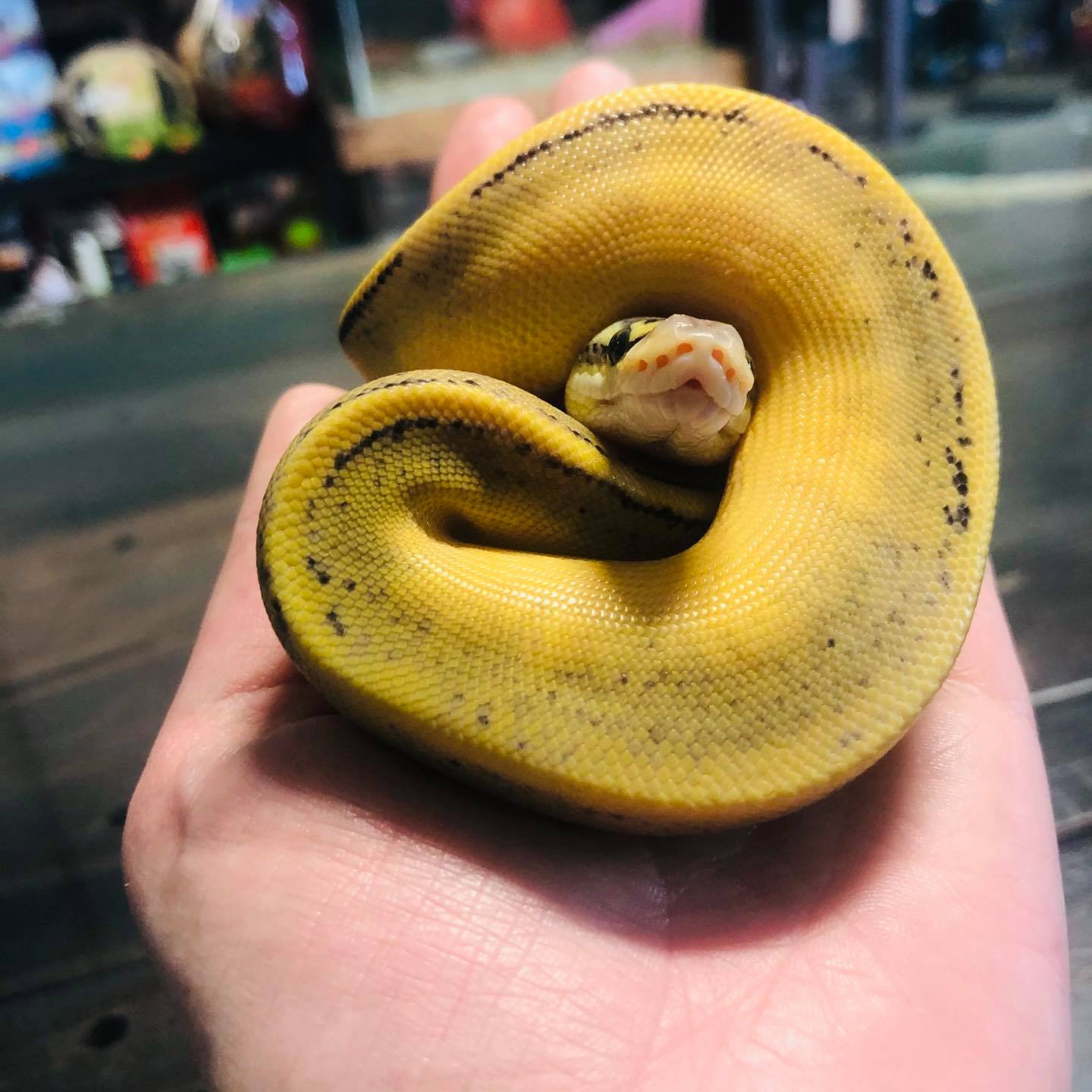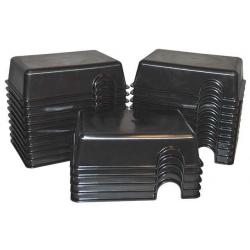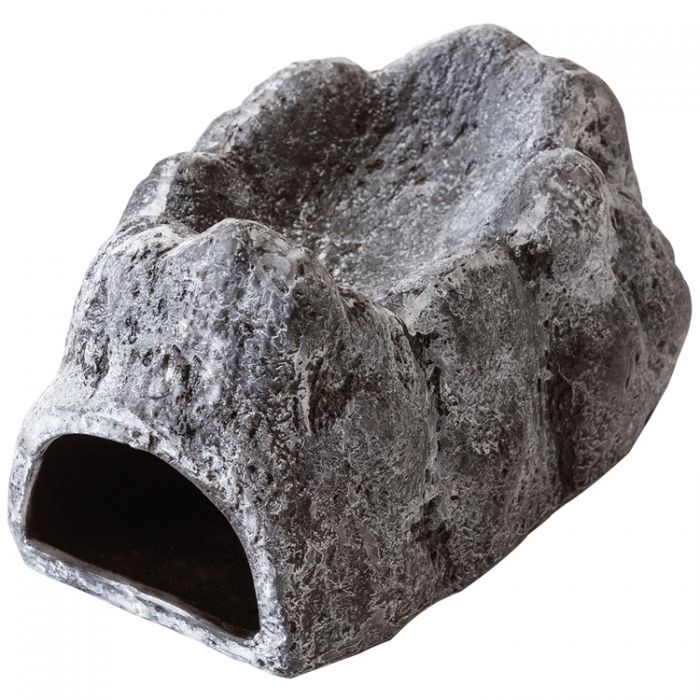
Habitat:
Terrarium: There are two ways to house your snake. The first and most popular way is in a PVC enclosure. The second method (used more commonly by breeders) is in a rack system. Glass enclosures are NOT a great option for Balls and can lead to many issues.
Many believe that there is no maximum size to the enclosure - provided the snake has plenty of hides and ample foliage. We prefer 2*2*1 PVC for baby snakes and up to 4* 2 *1 for an adult.
Ball pythons are known to be shy animals and (like other snakes) will seek comfort in a small and dark space. In the wild, they tend to hide in holes and ambush prey.
Never Mix snake species in the same enclosure! We also always avoid co-housed animals. Ensure your animal lives its safest and most happy life by proving its own secure and appropriate enclosure. We highly recommend proper quarantine procedures when introducing a new snake into your collection (if you require more information, please reach out).
Heat: As ball pythons are cold-blooded, they rely on external heat and will need a healthy range of temperatures throughout the enclosure.
The warm side of the enclosure should be between 87 - 92F, and the cool side should be 75- 80 F. As a beginner, it is important to have two thermometers; affixed to each end of the cage so you can see the exact temperatures at all times. We also recommend having your UTH or heat tape on a thermostat to prevent over or under heating. We silicone probes to prevent your animal from injury due to getting stuck on taped down probes in the enclosure.
If your enclosure is too small, creating a proper heat gradient will not be possible.
Avoid overhead heat lamps as this tends to dry out the enclosure and forces the animal to bask in a way that is not natural (i.e. stressful) to them.
Humidity: A ball python’s humidity should not drop below 50%, but 55% - 60% is ideal. As a beginner, go to your local pet store and pick up a hygrometer to accurately measure the humidity in your snake's enclosure. An easy way to adjust humidity levels in the enclosure is by increasing/decreasing the water bowl size.
Substrate: Ball pythons are clean animals, and choosing a substrate is not tricky. The more porous the substrate (like mulch), the more it will retain moisture and bolster the humidity. We use a peat/coco/moss bioactive mixture with our adult snakes.
I use paper-towel as my preferred bedding for ball pythons, especially as a baby or for new animals. It is easy to clean, monitor deification and prey will not be soiled as you feed your snake.
Remember that cedar is not suitable for bedding as it is toxic to snakes.
Hides: Like most snakes, ball pythons seek dark, secure places and providing the right amount of hides is critical to the snake's sense of security. If the snake does not feel secure, it will stress and give you feeding and possibly aggression problems. Provide a hide on both the warm side and the cool side of the enclosure. If your enclosure is quite large, then providing more hides will be necessary. Many great hide options are available, from ABS hides to moist decorative hides. We typically don't go too large for our hides, ensuring the snake fits comfortably. Avoid cork rounds or hides that your animal could get stuck in or inhibit your ability to check the animal properly.
Lighting: Ball pythons do not need special lighting requirements and will do just fine with the natural photocycle of your home. A UVB could be beneficial, and we do use them with some of our snakes on a 12/12 cycle.
Water: Ensure there is always fresh water in your ball python's cage; change the water every two days. If the water gets dirty beforehand, change it immediately
Cleaning: Make sure you spot clean the cage at least once a week. Do a thorough cleaning once a month. Please remove all cage contents and disinfect them with an appropriate cleaning solution (we use F-10 or cleaning vinegar solution). The substrate should also be wholly changed often or topped with an active bio crew. If you are using paper-towel, change it weekly or when soiled.
Feeding:
Ball pythons can feed on Rats and Mice their entire lives, but nutritionally speaking, it is better to give them a diverse prey mix. We use Mice, Rats, quail, chicks and the occasional ASF or another rodent type commercial snake prey. They should be fed as a baby, one appropriately sized meal per week. To accomplish a properly size meal means that the mouse/rat should be the same size or slightly bigger than the snake's thickest part around. When your snake reaches Adult age (over two years), we stretch out feeding to every 10-14 days, again with a variation in prey and appropriately sized.
We only recommend Frozen Thaw or Freshly killed prey, as live prey can cause injury to your animal.
Only feed your animal, clean, farmed prey. Never feed "found," or wild prey as the prey can be contaminated with anything from pests like mites/fleas/ticks to unknown poison or pesticides.
Always use tongs when feeding to avoid accidental bites.
Shedding:
You will be able to recognize when your snake begins to shed; First, the stomach will start to turn pink, then the snake's skin will begin to get significantly duller, and finally, the snake's eyes will become milky and appear opaque. This last stage is called "in blue" Eventually, the eyes will clear up, and within the next 36 hours, you can expect your snake to shed.
Depending on your snake's age, it will shed its skin every 4 - 6 weeks. Ball pythons do not typically have problems shedding as their humidity requirements are not too intensive. Although should your ball python shed incompletely, rub them with mineral or coconut oil. Then check the humidity in your enclosure and adjust as necessary.
It is always important to check the snake after it has shed to ensure that there is no skin remaining on the tip of its tail & that the eye caps have been completely removed.
If you find that your snake is not shedding well, there are several things you can do to assist it. To increase humidity, merely move the snake's water bowl over the heat source. If necessary, consider decreasing the ventilation in the enclosure to more successfully trap the humidity or switch the bedding to a more mulch type bioactive mix.
Handling:
Ball pythons are known to be very docile animals and are very comfortable with being handled. On a rare occasion, you will find a snake that is snappy. Even with these snakes, regular handling and proper husbandry should eventually calm them down.
It is essential NOT to handle your snake for at least 24-36 hours after it has eaten as this can disrupt the digestion of its food and lead to regurgitation. Aside from dealing with the awful smell and mess, it is bad for the snake and can lead to future eating problems or death. It is also best not to handle your snake while it is in the process of shedding. The main reason for this is because as eyes turn "in blue," the snake's ability to see becomes greatly diminished. As one can expect, when an animal cannot see the surroundings, it will become a lot more defensive and be more likely to strike. As you keep your snake longer, you will learn when it is appropriate to handle them.
Some people are concerned about how often they can handle their snake. The short answer is that as long as your snake does not become agitated/stressed and has digested the meal, you can handle it as frequently as you like.
Do not let your animal-free roam; they can move quickly and fit in small dangerous places. When you have your animal out, keep other pets away, and always supervise small children. Dropping or squeezing your animal can cause serious, often deadly internal injury.
Ball Python Fun Facts:
Ball pythons are from Africa and are amongst the smallest of the Python family. They tend to roll in a ball when frightened or stressed. Ball Pythons can live typically up to 40+ years with optimal conditions! Enjoy your new pet!
Never release unwanted animals into the wild (especially snakes) as they are unable to survive our climate! We here at SHP are happy to rehome your reptile if you are unable to care for it any longer.
**All information in this sheet is meant as a good start for your new ball python; please also seek advice from a qualified exotic vet.**
Site by Bradley Hopkins @ SHP


